Immigrant Experiences, Media, and Public Opinion Analyses of CA District 33 (Rep. Ted Lieu)
Lena Hu
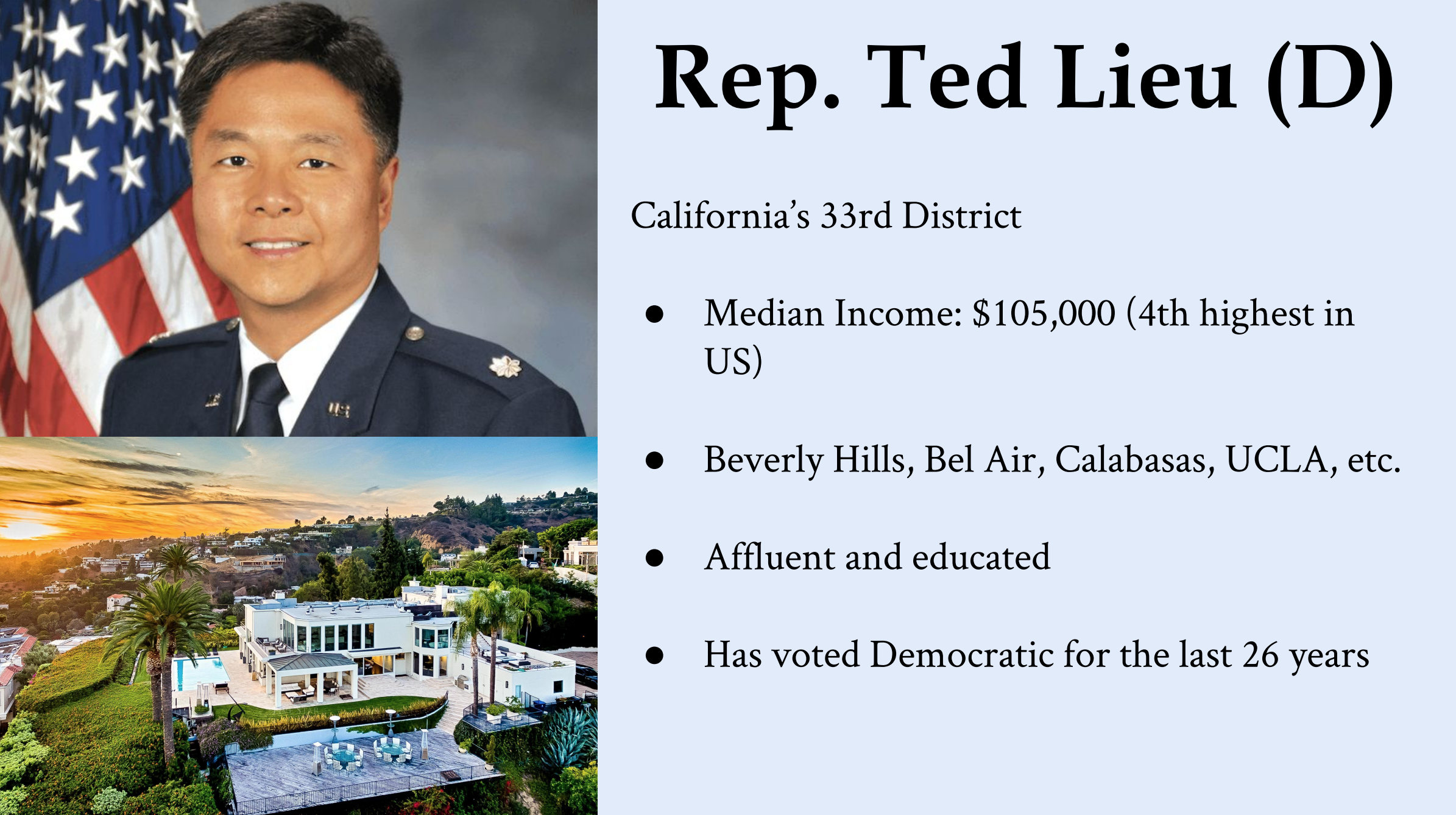
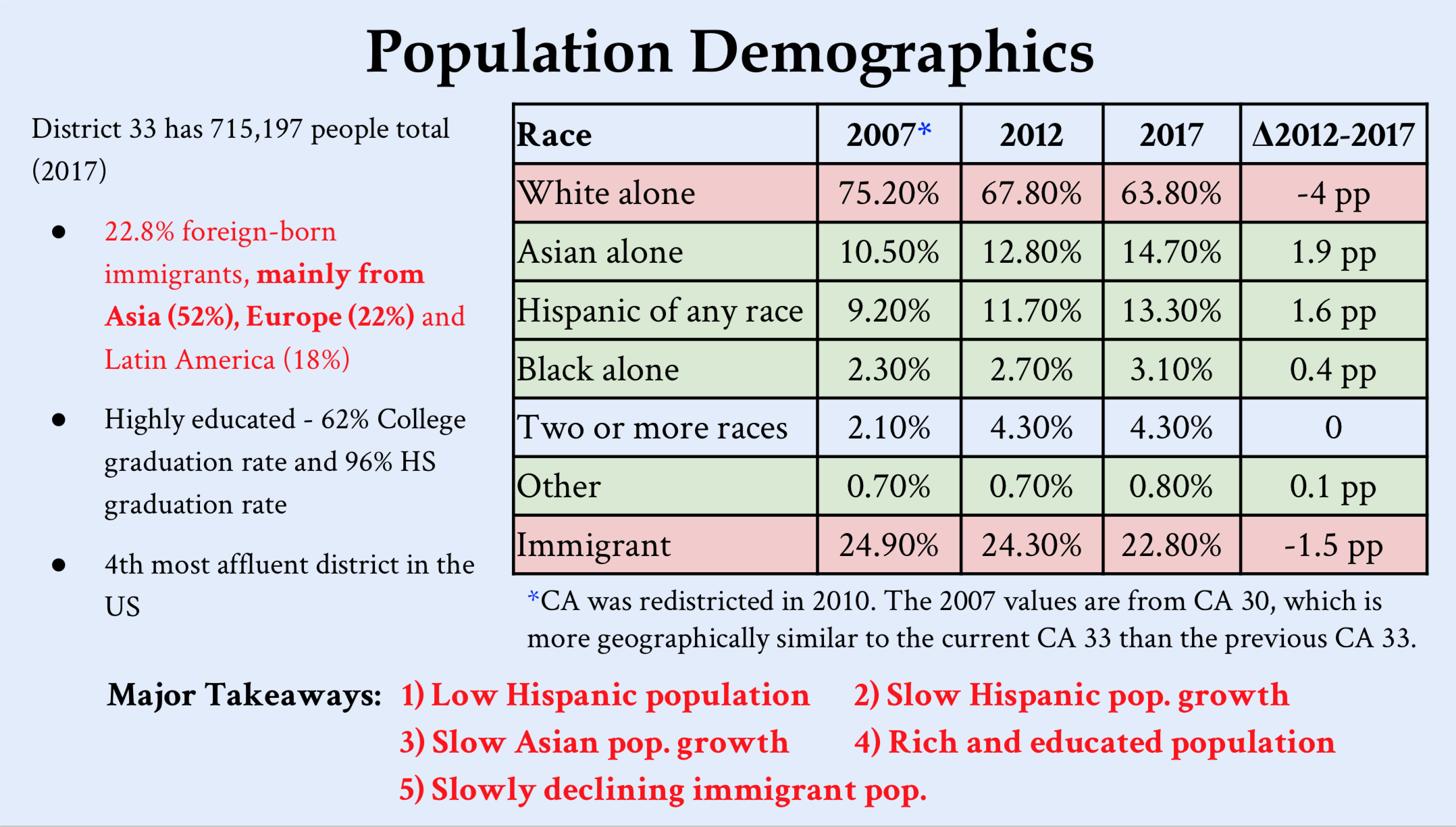
Slide 1: District 33 Population Demographics
California District 33 is mostly White (~64%), Asian (~15%), and Hispanic (~13%). Although it has a sizeable immigrant population (~23%), this population has been slowly declining over time. The immigrant population is also predominantly Asian (52%) and European (22%) rather than Latin American (18%). The 13% Hispanic population overall is low compared to the US (17.6% Hispanic) and especially low compared to California as a whole (39% Hispanic). This district is notable for its extreme affluence (the median income is $105,000) and its high education levels due to the presence of a well-resourced public school system and universities including UCLA, Pepperdine University, Santa Monica College, and others. Although California was redistricted in 2010, the redistricting did not significantly affect the racial breakdown of the district; it remained predominantly White with a significant Asian population and comparatively smaller Hispanic and Black populations. Overall, California District 33 has a low Hispanic population, a declining immigration population, and slow Hispanic and Asian population growth (less than 2 pp per group over the past 5 years).
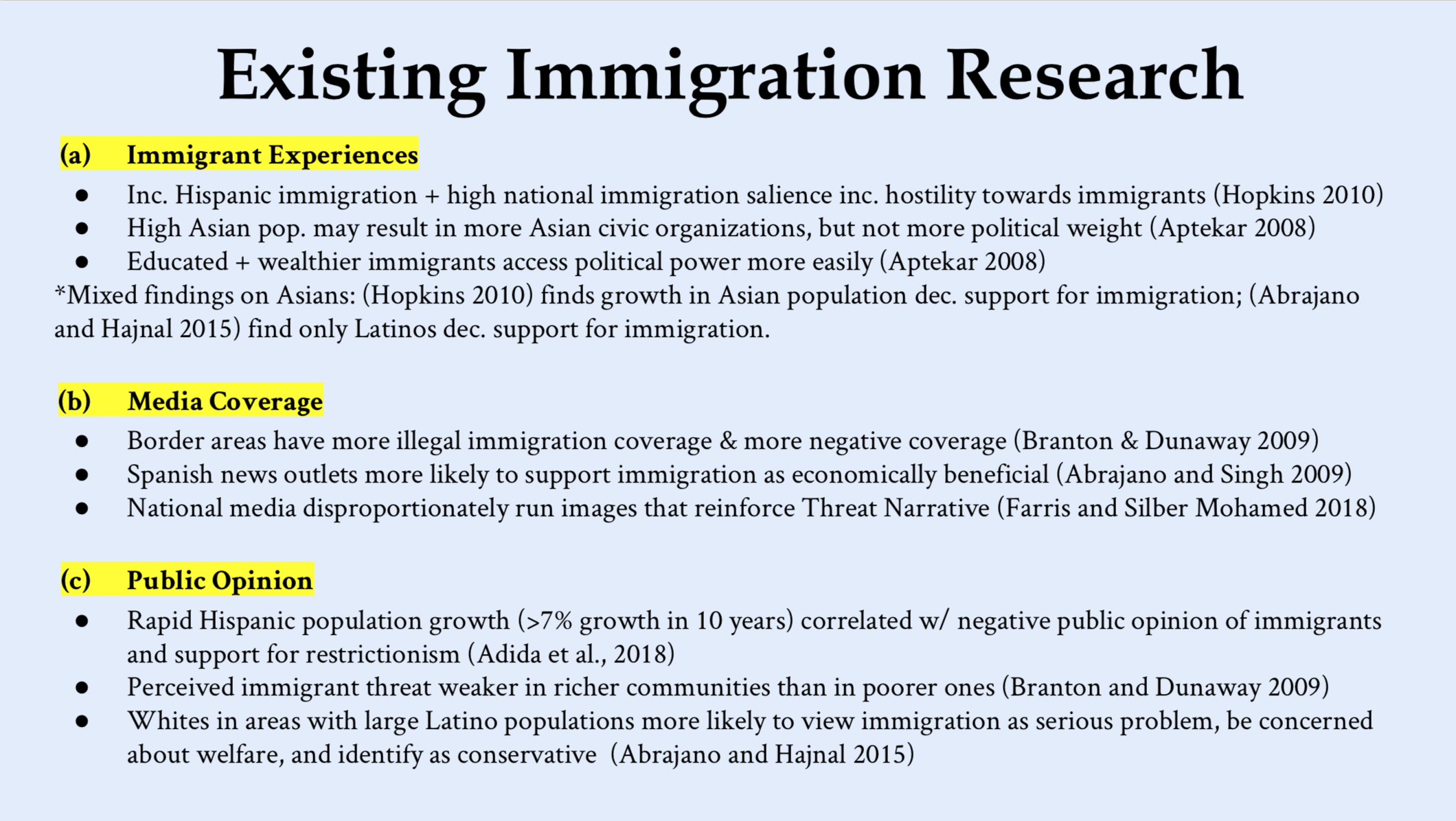 Slide 2: Existing Immigration Research
Slide 2: Existing Immigration Research
(a) In terms of immigrant experiences, existing research finds that increasing Hispanic immigration at a time of high national immigration salience increases hostility towards immigrants (Hopkins 2010). Some scholars have found a similar, but weaker effect for Asian immigrants (Hopkins 2010), while others find that only Latino immigration is correlated with decreased support for immigration (Abrajano and Hajnal 2015). Although a high Asian population may result in the formation of Asian American civic organizations, this does not mean Asian Americans have more political influence even in cases where an Asian American has been elected to public office (Aptekar 2008). (b) In terms of media coverage, national media overall covers immigration in a negative way, disproportionately covers illegal immigration, and primarily uses images of men and boys that reinforce the Latino Threat Narrative (Farris and Silber Mohamed 2018). News organizations closer to the Mexican border run more stories on illegal and Latino immigration and focus on more negative aspects of immigration (Branton and Dunaway 2009). On the other hand, exclusively Spanish news outlets are more likely to highlight positive aspects of immigration than English or English-Spanish news outlets (Abrajano and Singh 2009). (c) In terms of public opinion, rapid Hispanic population growth, defined as greater than 7% growth in 10 years, is correlated with higher support for restrictionism (Adida et al., 2018). In fact a large Latino population alone (without rapid growth) is correlated with White populations seeing immigration as a serious problem, being more concerned about welfare, and switching to the Republican party (Abrajano and Hajnal 2015). Finally, the perceived immigrant threat is weaker in richer communities (Branton and Dunaway 2009) and in predominantly Democratic areas (Abrajano and Hajnal 2015).
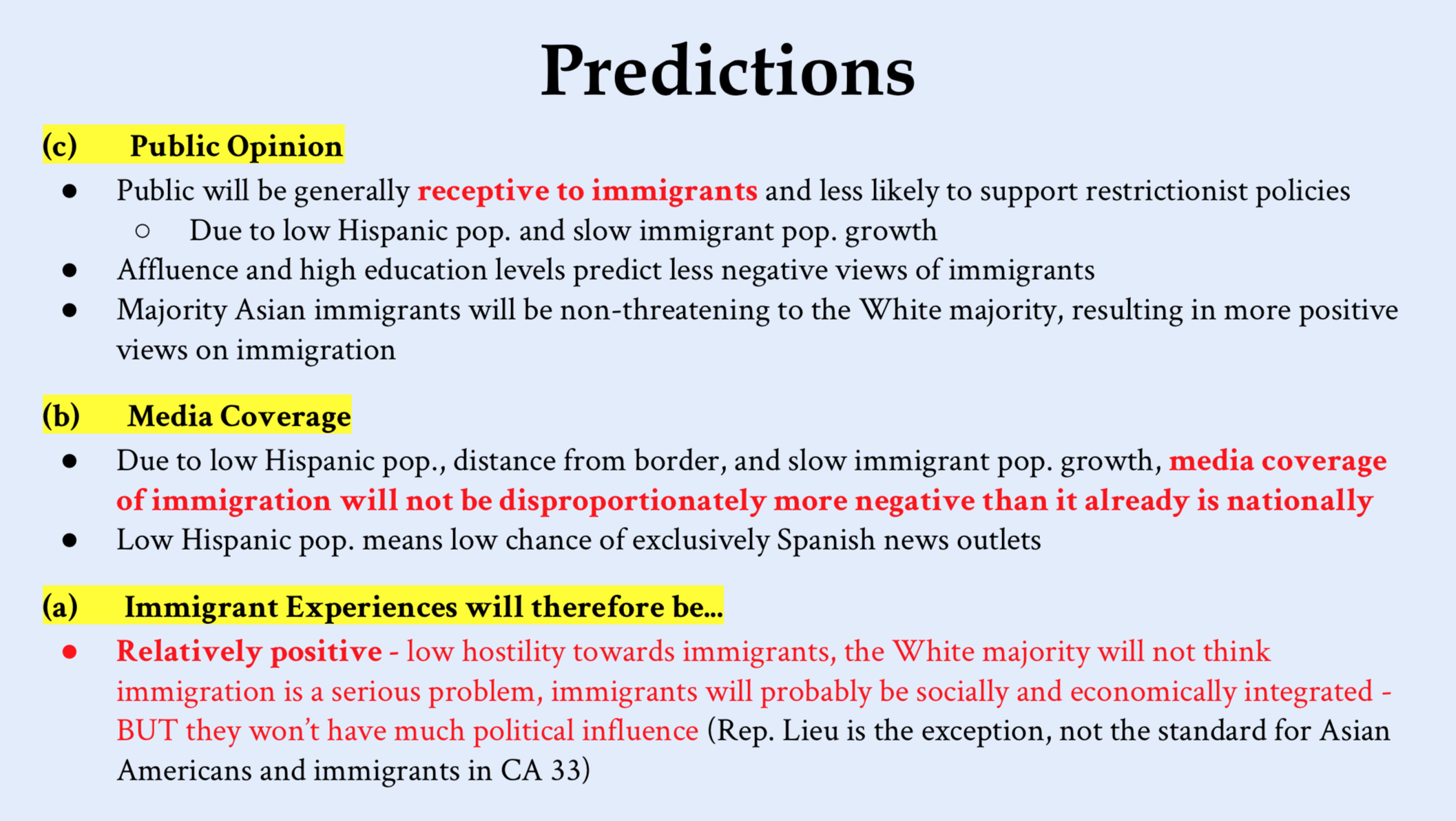
Slide 3: Predictions
(c) Since CA 33 has a low Hispanic population, slow Hispanic and Asian population growth (less than 2 percentage points over the past five years), and a slowly declining immigrant population, existing research would predict that public opinion on immigration will be supportive rather than restrictionist. People will probably not think immigration is a serious issue. Given that the immigrant population is over 50% Asian and less than 15% Hispanic, the White majority will not feel as threatened as they would in an area with mostly Hispanic immigrants. The high income and education levels, combined with the strong and consistent Democratic partisanship, also predict less negative public opinion of immigrants. (b) The low Hispanic population, slow immigrant growth, and distance from the border suggest that media coverage of immigration in CA 33 will not be disproportionately more negative than it already is. It will still have the predominantly negative spin that national media on immigration exhibits across the country. Given the low Hispanic population, it is unlikely that there will be many exclusively Spanish news outlets, which are known to have more positive coverage of immigration. (a) All of these characteristics combine to suggest that immigrant experiences will be positive, with low levels of public hostility and facilitated social and economic integration. This does not mean immigrants will have political influence; research has shown that even areas with high immigrant densities and elected immigrant officials have often blocked immigrants out of the political process (Aptekar 2008). Therefore, even though Representative Lieu is a Taiwanese-American immigrant, this does not suggest that Asian Americans will be strongly politically incorporated in other ways.
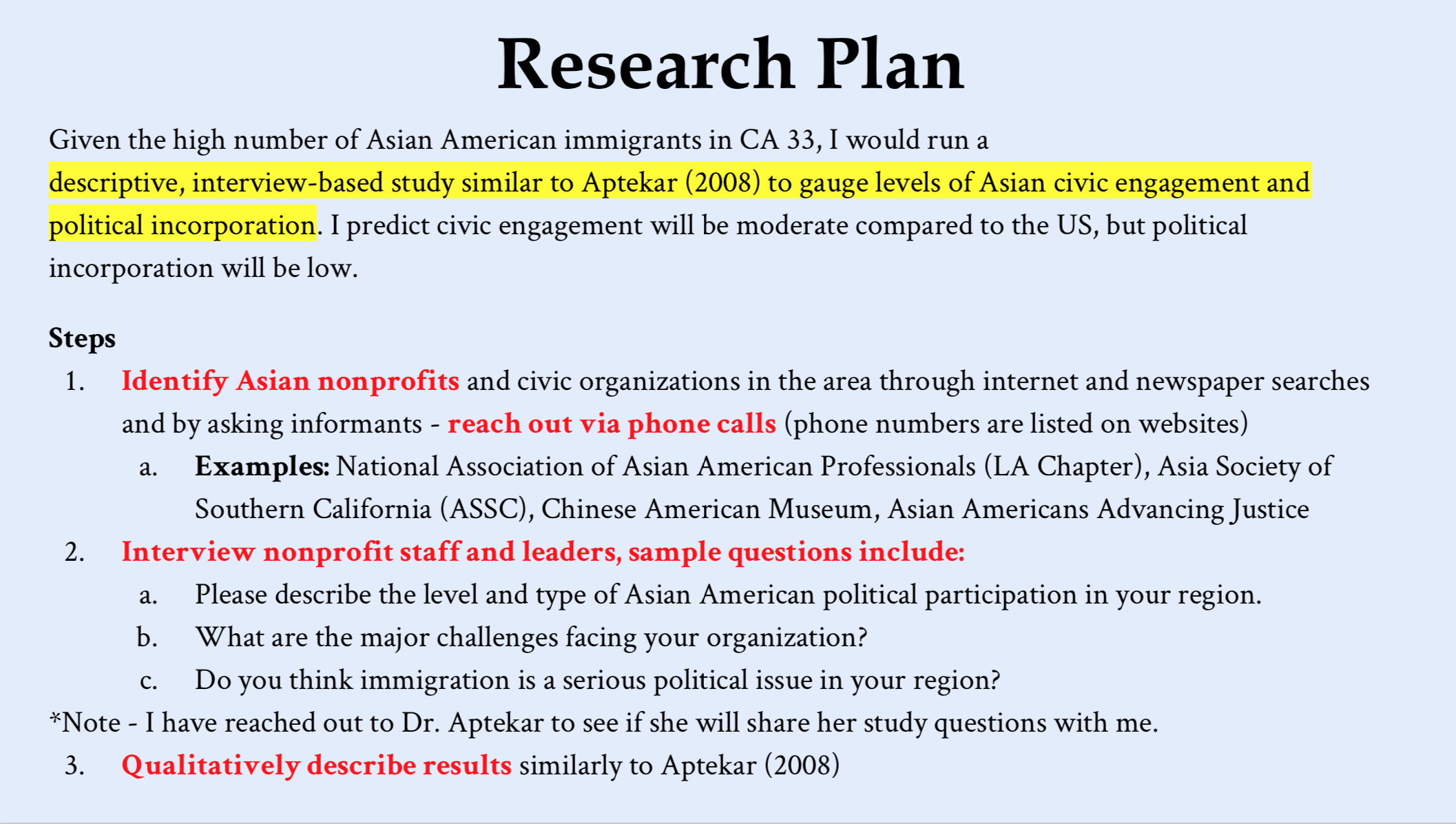
Slide 4: Basic Research Plan
I plan to run a descriptive, interview-based study similar to Aptekar (2008) to gauge levels of Asian civic engagement and political incorporation. Given the high Asian population in this district and the especially high young adult Asian population at UCLA, I predict that there will be a moderate to high amount of Asian American civic engagement compared to the rest of the United States. I also predict high levels of Asian American economic integration into the skilled workforce. However, I predict low Asian American political incorporation, measured in terms of government outreach to and support for immigrants; political mobilization such as voter registration drives, public advocacy, and protests; and voter turnout. My research plan begins with identifying all the Asian and Asian American nonprofits and civic organizations through District 33 via internet searches, newspaper searches, and asking informants. A cursory Google search already returned a number of organizations, including the National Association of Asian American Professionals, the Asia Society of Southern California, and the Chinese American Museum. I will then create a list of questions about immigrant political incorporation to ask organization leaders and staff. I have reached out to Dr. Aptekar to see if she would share the questions from her study with me, and if she does, I will use questions based on her study. Preliminary questions that I have brainstormed include: “Could you describe the types of Asian American political participation in your region?” and “Do you think immigration is a serious political issue in your region?” I will reach out to the organizations via email and/or phone, both of which are publicly listed on most of the organizations’ websites. I will qualitatively describe and analyze the responses in a report similar to Aptekar (2008) to either confirm or reject my hypothesis, making sure to address the significance of Taiwanese-American Representative Lieu the way Aptekar did with Mayor Choi of Edison.